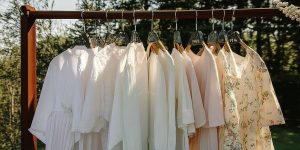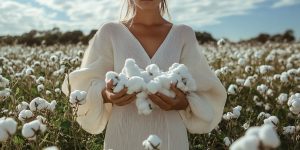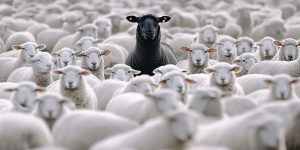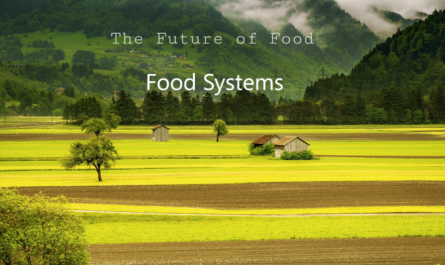A simple guide to the 5 most-used materials in fashion—and what that means for the planet.

If you’re trying to shop more sustainably, you’ve probably looked at a clothing tag and wondered, What does this actually mean?
Cotton sounds natural. Polyester sounds like plastic. And viscose… sounds fancy? The truth is, fashion materials aren’t always what they seem—and how they’re made plays a huge role in their impact on people and the planet.
Let’s break down the 5 most common materials in your closet. You’ll learn what they are, how they’re produced, and why they matter.
1. Cotton: A Natural Fibre with a Heavy Footprint

What it is: Cotton is a plant-based fibre made from the fluffy bolls that grow around cotton seeds. It’s been used in textiles for thousands of years.
How it’s made: After harvesting, the cotton is ginned (to separate fibres from seeds), then spun into yarn. Conventional cotton farming relies heavily on water, fertilizers, and pesticides.
Why it matters:
- Uses around 16% of global insecticides—more than any other crop
- Extremely water-intensive—a single T-shirt may need 2,700 litres of water
- Linked to poor working conditions and farmer debt in some regions
Better option: Organic cotton certified by GOTS or OCS avoids harmful chemicals and promotes safer farming practices.
2. Polyester: The World’s #1 Fibre… and It’s Plastic

What it is: A synthetic fibre made from petroleum—basically plastic, just spun into thread.
How it’s made: Crude oil is processed into polyethylene terephthalate (PET), then melted and extruded into fibres.
Why it matters:
- Non-biodegradable—can take up to 500 years to break down
- Sheds microplastics with every wash, polluting oceans and rivers
- Production emits high levels of greenhouse gases
Better option: Recycled polyester (rPET) made from bottles reduces waste, but still has limitations. More on this in Post #4.
3. Viscose (Rayon): From Trees to Toxic

What it is: A semi-synthetic fibre made from wood pulp—often bamboo, eucalyptus, or beech trees.
How it’s made: Trees are turned into pulp and chemically processed with solvents like carbon disulfide to create yarns.
Why it matters:
- Up to 30% of viscose comes from endangered or ancient forests
- Processing can pollute air and water, affecting workers and communities
- Though plant-based, the fibre is heavily chemically altered
Better option: TENCEL™ Lyocell or Modal, made using closed-loop processes that recycle chemicals and water.
4. Wool: Warm, Natural… and Emission-Heavy

What it is: A natural animal fibre from the fleece of sheep, alpacas, goats, and more.
How it’s made: Animals are sheared, and their fleece is cleaned, spun, and woven into yarn.
Why it matters:
- Sheep farming produces methane emissions, a potent greenhouse gas
- Some farms use inhumane practices like mulesing
- Processing can involve toxic cleaning agents unless certified
Better option: Look for certifications like Responsible Wool Standard (RWS) or ZQ Merino.
5. Elastane: Stretchy but Unsustainable

What it is: Also known as spandex or Lycra, elastane is a stretchy synthetic fibre made from polyurethane.
How it’s made: Derived from fossil fuels, it’s chemically processed into fibres that provide stretch.
Why it matters:
- Non-biodegradable and difficult to recycle, especially when blended
- Just 5% elastane can make recycling or biodegrading a garment almost impossible
- Often found in fast fashion items designed for short-term use
Better option: Choose quality over quantity. Wash gently and wear often to extend its life.
Final Thoughts: Labels Are the New Literacy
Understanding what your clothes are made of isn’t just about shopping smarter—it’s about seeing behind the curtain. Fashion materials affect everything from carbon emissions to water use, deforestation to plastic pollution. The good news? Small shifts in awareness can lead to big impact over time.
Did you find any of those materials on your clothing labels yet?
Coming up next: Bamboo, Viscose & Rayon: Why They’re Not as Natural as They Sound
Let’s keep decoding fashion together.




It’s crazy to think about how much water it takes to produce just one cotton T-shirt! I had no idea conventional cotton farming had such a heavy environmental toll. Organic cotton sounds like a better choice, but I wonder how widespread it is in the market today?
Yes, it’s really surprising how much water one cotton T-shirt can use. A lot of people don’t know how hard conventional cotton is on the environment.To answer your question: organic cotton is growing, but it still makes up only about 1–2% of all cotton used in the world. That means most clothes are still made from regular cotton, but more and more brands are starting to offer organic options—especially in Europe.
Look for labels like GOTS (Global Organic Textile Standard). That’s one of the most trusted certifications for organic cotton and better farming practices.
Organic cotton isn’t perfect, but it’s a better choice, especially if you buy less and wear it longer. Thanks for your comment!